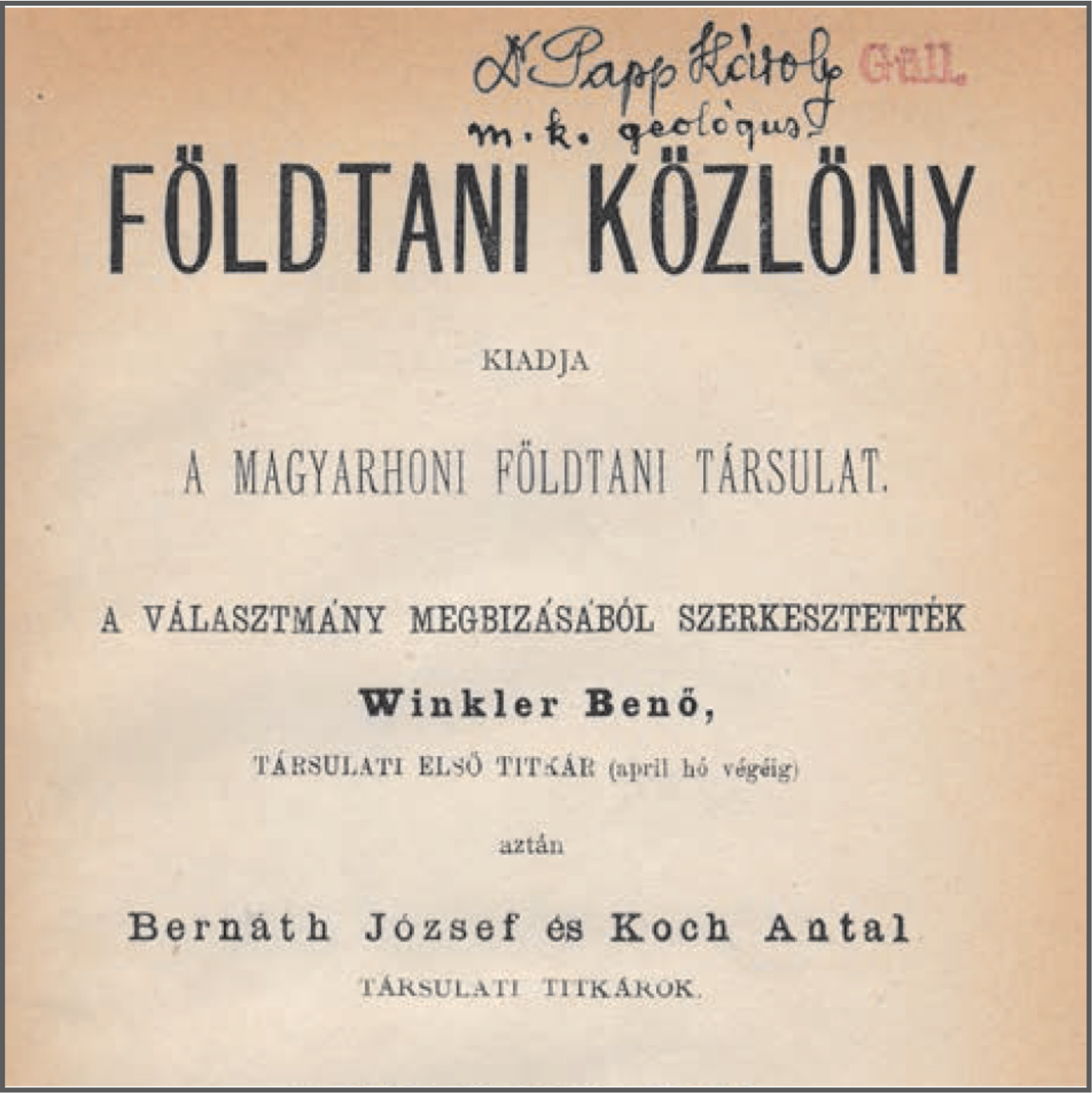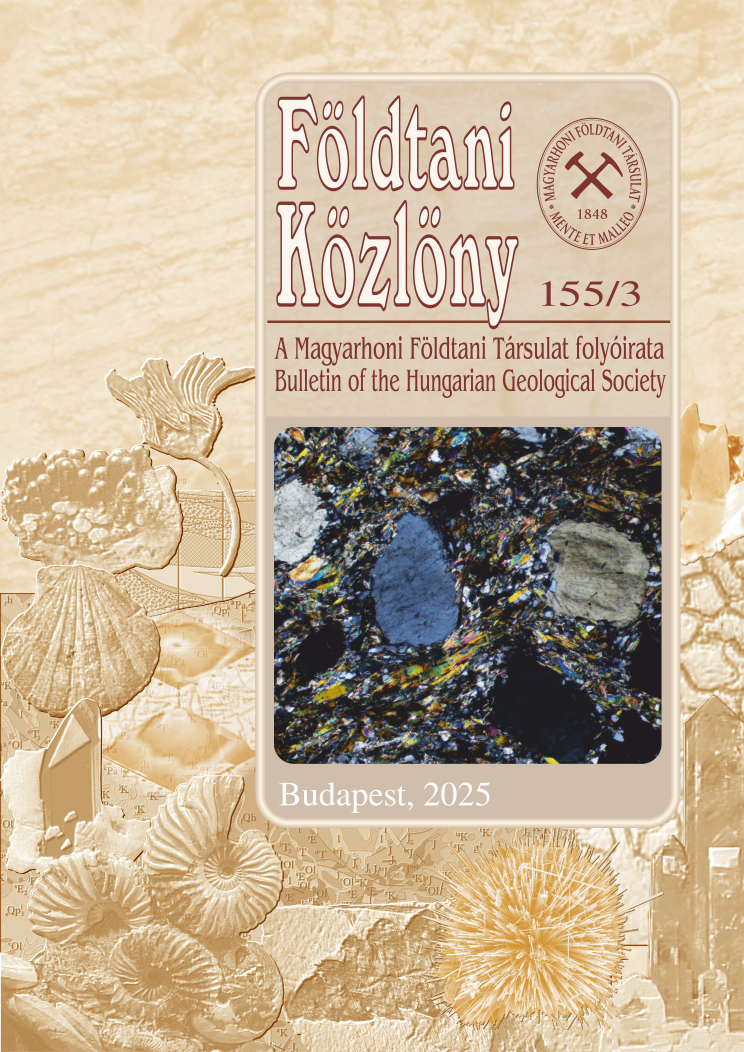History of Földtani Közlöny, Bulletin of the Hungarian Geological Society
Abstract
Földtani Közlöny (hereafter: the Bulletin), with its 150 volumes, is one of the oldest scientific periodicals in Hungary still in print. Its history has always been a faithful mirror of the changes in the organization and in the financial situation of its publisher, the Hungarian Geological Society (Magyarhoni Földtani Társulat, MFT, hereafter: the Society).
Precedents. The Bulletin replaced Magyarhoni Földtani Társulat Munkálatai [Proceedings of the Hungarian Geological Society]. The five volumes of this first periodical of the Society were published irregularly since 1856 but the last three issues (1867–1870) appeared nearly annually. Vols II–V contained both shorter and longer papers, as well as reports and documents of the life and activities of the Society. In addition to these, the Bulletin, which replaced the Proceedings in 1871, also includes geological news and reviews of geological books and periodicals due to its frequent publication schedule.
Period of founding and finding the profile of the journal (1871–1885). The publication of the Bulletin was made possible by the organizational and financial strengthening of the Society and by the establishment of the Royal Hungarian Geological Institute (Magyar Királyi Földtani Intézet, MKFI, 1869). The Institute took over the task of publishing annals with voluminous papers and annual reports on the geological surveying of the country, whereas the Society published its Bulletin issued in several numbers per year containing shorter articles. The Bulletin was edited by the first and second secretaries of the Society until 1948. Society members received it until 2000 for the membership fee or for a reduced subscription fee. The first 15 years of the Bulletin was a period of frequent changes. In 1878 [Vol. 8] the format changed from small to large octavo. In 1879 [9] the journal became practically bilingual. In order to strengthen its scientific character, in 1880 [10] Földtani Értesítő [Geological Reports], a new journal was founded, which published popular articles and took over all the sections of the Bulletin other than original papers. In 1883 [13] Földtani Értesítő discontinued, and not only the “exiled” sections returned to the Bulletin, but the Annual Reports of the Geological Institute were also added. Being too burdensome for the Society, the joint publication lasted until only 1885 [15], but the alliance of the Society and the Institute survived: until 1949 [79], the Bulletin had been the “official journal” of the Geological Instituteas well. For a long time, the journal exchanges for the Bulletin were also managed by the library of the Institute.
Years of consolidation (1886–1918). From 1886 to 1918, the Bulletin changed little in character, although József SZABÓ, president of the Society, wanted to develop it into a reference journal of Hungarian geology, maintaining its role as a publication forum of the members of the Society. Publication costs amounted to 40-60% of the annual expenses of the Society but publishing has never been a real problem, thanks in large part to state subsidy received annually from 1887 [17] and tripling by 1910 [40]. The systematic recruitment of members from 1908, a controversial matter, and the establishment of two new Sections (Speleological, 1910/13 [40/43] Hydrological, 1912 [42]) contributed to the further increase of the volume of the journal. World War I broke this trend, but by 1918 [48] it was only a decline in the number of pages, as the number of copies reached its peak (1,200) in this year, surpassed only in as late as 1955.
A period of struggle from the end of World War I till the Communist takeover (1919–1948). After the collapse of 1918, assets of the Society lost their value and state subsidy became unpredictable. During this period, mining industry companies became important supporters. Publication costs of the Bulletin amounted to 70-80% of the annual expenses. Therefore, until 1933 [63], generally only one, usually rather slender, issue was published per year, with two, then one year delay. This led to the shortening of articles, and omission or shrinking of sections other than the one containing original papers. In 1931 [61] the bilingualism of the journal changed, articles were published either in Hungarian or in a foreign language (mainly German) with a foreign or Hungarian abstract, respectively. From 1943 [73], a period of long delays in publication and of combined volumes with limited content started again. The first (combined) volume [73/74] was published only in 1947.
Under state control (1949–1989). In 1948 [78], the MFT had to join the state-created Federation of Technical and Scientific Societies (MTESZ). This umbrella organization, providing state control of scientific associations, also took over the publication of the Bulletin. Then, after several changes, the Bulletin had been published by the Akadémai Kiadó (Publishing House of the Hungarian Academy of Sciences) from 1954 [84] to 1989 [119]. State subsidy, which came mainly through the MTESZ and through special membership fees paid by state-owned mining companies, provided financial security and stability as compared to the previous period. Editing was done by a permanent editor (from 1967 [97] the president of the Society) helped by an editorial board and by a technical editor (who was also a geologist). It was a great disadvantage, however, that science policy defined the role of the Bulletin as a journal of strictly national reach. Therefore, papers have almost never been published in foreign languages, except for their abstracts. Number of copies peaked at 2,100 in the early 1980s, when the Society itself reached its peak membership (1,680 in 1980). By this time, however, stability increasingly transformed into stagnancy. From 1986, the decline in state subsidy led to an increase in the delay of publications, reaching as much as two years by 1989/1990.
The Society and the Bulletin again on their own feet — the first steps (1990–2000). In 1989, scientific societies were freed from state control but deprived of state support. The era of delays of publication combined with the shrinkage of the volume of the Bulletin once again arrived. However, compared to the years between the two world wars, this period lasted for a shorter time, and ended by the mid-1990s, mainly thanks to the support of MOL Plc. The changeover to computeraided editing, layout and digital printing was done, and since 1995 [125] the quality of paper and print has been excellent. Since 1997 [127], an editor-in-chief oversees and controls the editing process. From separate subscription fees to free online access — Radical changes in the new millennium (2001–2019).
From the turn of the millennium, IT revolution and financial troubles have brought about drastic changes in the access to the Bulletin. Until 2000 [130] Society members received the Bulletin for their membership fee. In 2001 [131], a special subscription fee had to be introduced, which caused the fall of the number of printed copies from about 1250 to 600. In 2008 [138] the print format was changed from B5 to A4, the cover and the inside were both redesigned. Papers have been available through the web from 2013 [143] for a subscription fee, from 2015 [145] for the membership fee, and from 2017 [147] for free. Since then, papers are supplied with a DOI. Thanks to retrospective digitization, all the volumes of the Bulletin are downloadable from the web for free (including the journals of the Sections of the Society). At the same time, a web-based editing process was introduced. These developments led to the decrease of the number of printed copies to 270 by 2019. The journal is still predominantly Hungarian, although foreign (English) language papers are regularly published.
















